Home » Minerals » Legal Aspects of Rock Collecting
Legal Aspects of Rock, Mineral, and Fossil Collecting
By Timothy J. Witt, J.D.
|
Part 1: Introduction
Part 2: Determining Rock, Mineral, or Fossil Ownership and Possession Part 3: Additional Conditions, Limitations, and Prohibitions on Rock Collecting |
Part 3:
Additional Conditions, Limitations, and Prohibitions on Rock Collecting
Even with permission or consent, rock, mineral, and fossil collectors should be familiar with any conditions, limitations, or prohibitions applicable to planned collecting activities. Conditions, limitations, and prohibitions typically result from the application of various laws and regulations or the specific wishes of the property owners. With government land, discretion to adopt and implement policies regarding specimen collecting and related activities is granted to the local agencies tasked with administering and managing such government land. Thus, policies may differ with respect to government lands even when a large government agency like the Bureau of Land Management, the United States Forest Service, or the National Park Service administers and manages those government lands.
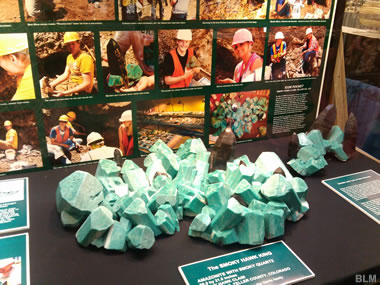
The world's most famous locality for amazonite and smoky quartz is in Colorado. There are thousands of other mineral collecting and commercial production sites within the state. In 2015 there were over 10,000 active mining claims in Colorado. Click to enlarge image.
Use Restrictions
One common restriction deals with the anticipated use of any rocks, minerals, or fossils collected. In many instances, permission is granted or even implied when rock collecting activities are purely for personal purposes, which includes hobby activities. In some cases, rock collecting activities that are for educational purposes are also permitted without further complication. Collecting activities that are done for a commercial purpose, however, are oftentimes restricted or prohibited. Commercial purposes would include not only collecting specimens for direct sale, but also for use in jewelry and other creative pieces that are then sold. Accordingly, it's crucial for the collector to know what limitations or prohibitions exist on collecting related to certain uses or end-purposes. For example, on all lands managed by the Bureau of Land Management or the United States Forest Service, commercial collections of rocks and other specimens requires special permit authorization.22 California law applying to certain public lands administered by the California Department of Parks and Recreation, referred to as "units," offers another example. In the case of California, certain areas are open only to personal, non-commercial rock collecting.23 Other state laws are less clear, but nonetheless would prohibit rock collecting if being conducted for commercial purposes.24 Use limitations are oftentimes taken very seriously and violators are punished. One such example occurred in Idaho, where a man who took 9,800 pounds of sandstone rocks from Bureau of Land Management lands to sell for landscaping purposes was subsequently convicted and sentenced to serve nine months in jail.
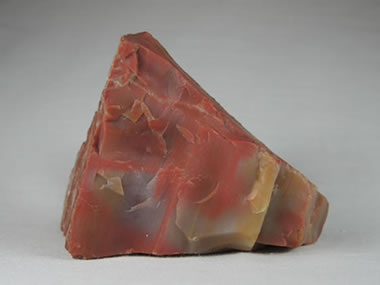
A nice piece of petrified wood suitable for lapidary work. The pore spaces in the wood have been completely silicified, and the piece is relatively free of fractures. It also has nice color. Petrified wood like this is very hard to find. Specimen is about three inches across.
Amount Restrictions
Another common restriction involves the anticipated amount of any rocks or minerals collected, in which cases the amount of rocks and minerals collected is most often measured in number, weight, or volume. In many ways, amount restrictions are closely related to use restrictions; it is assumed that someone taking a large amount of rock and other specimens is doing so for commercial purposes. Thus, collectors should know and closely abide by any amount restrictions. Oftentimes amount restrictions are vague and subject to interpretation.25 As a result, collectors should follow various "rules of thumb" and reasonableness standards when determining the amount of rocks or other specimens to be collected. Some restrictions are more specific. For example, limited quantities of petrified wood can be collected without a permit for non-commercial purposes on land managed by the Bureau of Land Management so long as no more than twenty-five pounds plus one additional piece are collected per day with a maximum limit of two hundred fifty pounds each calendar year.26 Collectors with an interest in fossils should note that similar rules and principles apply to fossil rocks found on Bureau of Land Management or United States Forest Reserve lands as well.27 California Department of Parks and Recreation lands have a defined weight rule as well, limiting takes to not more than fifteen pounds of mineralogical material or not more than one specimen plus fifteen pounds of mineralogical material.28 In Utah, state lands administered by the School and Institutional Trust Lands Administration are subject to weight restrictions as well with maximum limitations identical to Bureau of Land Management regulations. Unlike a weight restriction, Hawaii previously limited personal, non-commercial rock and specimen collecting on shoreline areas with a volume limit of up to one gallon per person per day. This restriction was more recently amended, however, to prohibit taking any amount.29 Demonstrating the complexity of determining the applicability of specific laws, rock collecting in "small quantities" for personal, non-commercial use appears to still be permitted in Hawaii State Parks that are not recognized as shoreline areas, so long as local laws do not prohibit such collecting.30
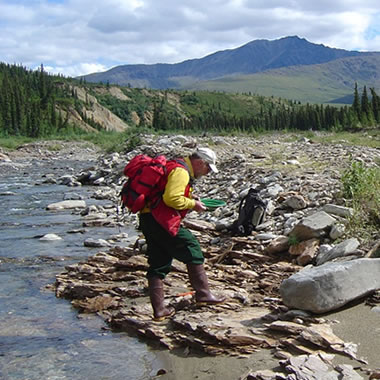
Restrictions are often placed on the methods that can be used while searching or producing rocks, minerals and fossils. In some areas only hand tools can be used. The depth or square footage of excavation or digging can be limited. There are often restructions on the use of motorized tools, vehicles, and explosives. Before working on any land, be sure that your methods will comply with what is allowed. USGS image.
Method Restrictions
Yet another restriction rock, mineral, and fossil collectors will often see related to the anticipated method for collecting. Once again, as with amount restrictions, method restrictions are also closely related to use restrictions. Certain methods lend themselves more to collecting for commercial purposes, particularly given their complication and expense. For example, on land managed by the Bureau of Land Management or the United States Forest Service, explosives, motorized or mechanical devices, and heavy equipment cannot be used for collection purposes. Additionally, collection methods that would result in destruction or disturbance of public lands, water, or assets are prohibited as well.31 For another example, California applies similar rules to Department of Parks and Recreation lands where tools cannot be used and, by implication, the ground and its features cannot be disturbed.32
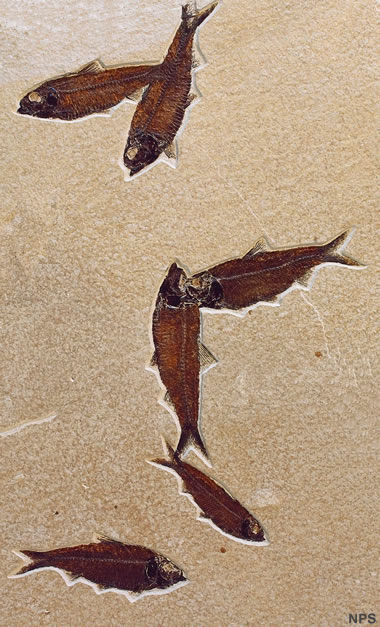
On most Bureau of Land Management and United States Forest Service lands, the collection of vertebrate fossil rocks is prohibited and criminalized. National Park Service photo.
Specimen Restrictions
Other common restrictions of which rock, mineral, and fossil collectors should be aware are specimen restrictions. Oftentimes use restrictions are related to public policies related to the attributed value of certain specimens, whether that value be monetary, educational, scientific, or otherwise.33 Most specimen restrictions prohibit the collection of certain types of specimens. For example, on Bureau of Land Management and United States Forest Service lands, while plant and invertebrate fossil rocks may be collected for non-commercial purposes, the collection of vertebrate fossil rocks is prohibited and criminalized.34
Rock collectors should also note that taking or removing rocks that have been specifically claimed or deemed the property of the federal government could result specifically in prosecution for theft of government property under 18 USC § 641.35 Other specimens of potential interest to rock collectors are subject to similar prohibitions.36 Rocks containing fossils are one particularly highly-regulated specimen. Meteorites are another.37 California, for example, also specifically prohibits the collection of all Indian artifacts, including rock items.38
Timing Restrictions
Timing restrictions, as a practical matter, may be the most common type of restriction in the sense that most landowners and government agencies will only permit the collection of rocks during daylight hours. For the rock collector, daylight restrictions should present no issue. In other situations, however, rock, mineral, and fossil collecting activities may be limited to certain times of the year or during specifically-identified "vacant" periods. For example, in Pennsylvania and many other states certain areas are closed off from public access or activities during certain times of the year to protect endangered bat species. Other areas that are usually open to the public may also be closed for weather or safety-related reasons during periods.
| This Stuff Really Happens! |
|
State confiscates 93-pound Petoskey stone from Michigan man
A warning to anybody collecting in Indiana The $17,000 Souvenir |
General Advice for Rock, Mineral, and Fossil Collectors
With so much to consider and the potential for missteps and peril, what's a rock, mineral, or fossil collector to do? Thankfully, diligent respect and consideration for several simple rules will assist rock, mineral, or fossil collectors in engaging in their hobby without running afoul of the law.
1. Don't rely solely on a single source without additional verification.
Anecdotally, many collectors use various sources to locate prime collecting areas. Such sources can include everything from paper maps and hardcopy guidebooks to online forums. In many instances, these sources identify certain areas and specifically label them as being freely open to rock, mineral, or fossil collecting. Unfortunately, while well-intended, such sources are sometimes based on outdated or incorrect information resulting in their being inaccurate. For example, laws or property ownership may have changed, and what was once permissible may no longer be. While such sources may be useful in narrowing down rock, mineral, or fossil collecting areas, collectors should always seek and obtain additional verification that collecting is permissible in a specific area.
2. Check out public information databases, GPS maps, and courthouse records for additional verification.
Collectors should verify ownership or possession of property using other resources like public databases, GPS mapping programs, and courthouse records. Given the official nature of such resources, they can be relied upon to provide useful and accurate information. For example, property tax database searches, while not absolute, can be helpful in identifying the owner or possessor of property and provide other relevant contact information, but oftentimes require knowing the name, identification number, or address of the property. GPS mapping programs oftentimes enable searchers to locate information about properties from a graphical point-and-click interface without already knowing owner names or property addresses or identification numbers. Courthouse records, particularly land ownership records, are most conclusive for verifying ownership or possession. Once again, however, locating courthouse records oftentimes requires searchers to know the name of the owner or possessor.
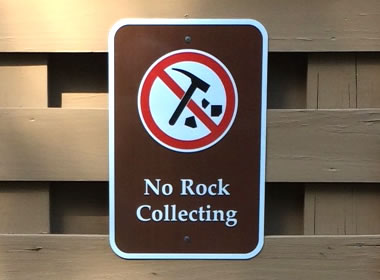
Although it is unusual to see a metal sign made specifically to post at locations where rock collecting is not allowed, enough of them are sold that companies selling metal signs have them available as a standard product.
3. Be aware of postings, notices, and signs on properties.
Collectors should respect all postings, notices, and signs on properties that they are considering entering. In many cases, collectors can easily and clearly determine the owner or possessor's position regarding granting someone permission to enter the property and search for specimens. Most obviously, "Stay Out" and "No Trespassing" signs should be respected. Likewise, postings, notices, and signs may also lay out applicable regulations regarding rock collecting, including any permissions that are required and any prohibitions, restrictions, or limitations. Collectors who are challenged for being on property may even find that the specific language in some signage can be interpreted permissively and, therefore, provides reasonable grounds for avoiding charges or liability.
4. Contact local offices of governmental entities or agencies.
Collectors looking to enter government land to search for and take specimens should contact the local office of the governmental entity or agency tasked with overseeing or administering such government land. For example, the Bureau of Land Management, United States Forest Service, and state park systems have local offices assigned to specific areas. In contacting the local office, collectors should inquire about any necessary permits, along with prohibitions, restrictions, and limitations. Oftentimes, making an attempt to contact the local office and follow appropriate procedures will engender cooperation, assistance, and respect from government officials, which, in turn, can go a long way towards obtaining any necessary permits and ensuring a positive and fruitful collecting experience. Collectors should also contact local offices to confirm applicable rules and procedures, as local offices are oftentimes given discretion to adopt and implement their own rules and procedures for specimen collecting.
5. Check for applicable laws.
Collectors would be well served to do a quick search for applicable laws before going on any collecting expedition. It may be easier to locate relevant laws and regulations than many collectors think. Although searches for applicable laws require close scrutiny of sources and examination for exceptions or qualifiers, many laws are fairly straightforward. Basic internet searches using the name of state or locality of interest and the name of any government entity or agency administering such areas, when entered with relevant phrases like "rock collecting" or "rockhounding," may provide substantial insight and clarity.
6. Seek legal advice where there is cause for concern.
In situations where ownership or possession is unclear or where the applicability of any prohibition, restriction, or limitation is in question, collectors should seek professional legal advice. This is all the more true where the "stakes" of collecting are higher such as when collecting is being performed for commercial purposes or the specimens being collected are of substantial value or universal interest. Although it may seem burdensome, finding out what is or is not legal in advance of a collecting trip can, in one sense, make a huge difference in the great success or utter failure of the trip.
Happy collecting!
Sample Language:
Surface Deed (Surface Estate – No Mineral Rights):
WITNESSETH, that in consideration of the sum of ONE AND 00/100 DOLLAR ($1.00), in hand paid, the receipt whereof is hereby acknowledged, the said Grantor does hereby grant and convey to the said Grantee, its successors and assigns:
ALL that certain tract, piece, or parcel of land situate in Springfield Township, Madison County, Pennsylvania, bounded and described as follows:
BEGINNING on line of the above described tract at the Northeast corner of land now or formerly of Smith, which was a part of the same tract; thence by land now or formerly of the said Smith, South 32-1/2 degrees West, 36 perches to a post; thence South 13-1/2 degrees West, 32.1 perches to a post; thence by land now or formerly of Miller, South 66 degrees East, 190.8 perches to a chestnut; thence by land now or formerly of Chen to land now or formerly of Tran on line of first described tract; thence by lines of first described tract to the place of beginning.
CONTAINING 81 acres.
EXCEPTING AND RESERVING, thereout and therefrom, all oil and gas together with the rents and royalties therefrom and also all coal and other minerals not heretofore conveyed away together with the usual mining rights and methods now known or hereafter discovered, necessary to remove, extract and mine the same underlying any portion of the above described property previously conveyed and the surface of which is no longer owned by Grantor.
Oil, Gas, and Mineral Interest Deed (Oil, Gas, and Mineral Estate – Limited Surface Rights):
WITNESSETH, that in consideration of the sum of ONE AND 00/100 DOLLAR ($1.00), in hand paid, the receipt whereof is hereby acknowledged, the said Grantor does hereby grant and convey to the said Grantee, its successors and assigns:
ALL OIL AND GAS, together with the rents and royalties therefrom AND ALSO ALL COAL and other minerals not heretofore conveyed away, together with the usual mining rights and methods, now known or hereafter discovered, necessary to remove, extract and mine the same, underlying those certain pieces, parcels or tracts of land situate in the Township of Springfield, County of Madison and Commonwealth of Pennsylvania…
Lease:
For and in consideration of the undertakings and covenants to be kept and performed by the Lessee, the Lessors do hereby lease, let and demise unto the Lessee the sole and exclusive right to mine and take away by all mining methods all of the merchantable and mineable stone underlying those certain tracts of land located in Madison County, Pennsylvania, as more fully set forth and described in Exhibit "A" hereto (the "Premises" hereinafter) together with the right to enter upon and under the Premises for the purposes of examining or convenient testing and mining all mining methods, and removing and carrying away said stone by such ways and means as may be necessary in the judgement of the Lessee for the successful mining and taking away of the same, and also, together with all and singular the mining, operating drainage, surface, and other rights and privileges owned by or vested in the Lessors, as fully as the same were acquired by the said Lessors, with waiver of surface support, both lateral and subjacent, and full release of damages to the surface, whether caused by the mining and removing of stone from the Premises or by adjoining tracts of land owned, operated or controlled by the Lessee and also, together with the right to transport stone from other lands owned, controlled, or operated by it in, under or through the premises. Lessee shall have the right to build roads, pipelines, and structures related to its stone mining and marketing activities, as well as the right to engage in all other types of activities customarily involved in mining.
| Part 1: Introduction
Part 2: Determining Rock, Mineral, or Fossil Ownership and Possession Part 3: Additional Conditions, Limitations, and Prohibitions on Rock Collecting |
|
Timothy J. Witt is an attorney with the firm of Watson Mundorff, LLP. He can be reached by email at  This article does not provide legal advice and does not create an attorney-client relationship. If you need legal advice, please contact an attorney directly. |
| Footnotes |
|
^ 22 See 43 CFR § 8365.1-5(c). Property and resources. (a) On all public lands, unless otherwise authorized, no person shall; (1) Willfully deface, disturb, remove or destroy any personal property, or structures, or any scientific, cultural, archaeological or historic resource, natural object or area; (2) Willfully deface, remove or destroy plants or their parts, soil, rocks or minerals, or cave resources, except as permitted under paragraph (b) or (c) of this paragraph; or (3) Use on the public lands explosive, motorized or mechanical devices, except metal detectors, to aid in the collection of specimens permitted under paragraph (b) or (c) of this paragraph. (b) Except on developed recreation sites and areas, or where otherwise prohibited and posted, it is permissible to collect from the public lands reasonable amounts of the following for noncommercial purposes: (1) Commonly available renewable resources such as flowers, berries, nuts, seeds, cones and leaves; (2) Nonrenewable resources such as rock and mineral specimens, common invertebrate and common plant fossils, and semiprecious gemstones; (3) Petrified wood as provided under subpart 3622 of this title; (4) Mineral materials as provided under subpart 3604; and (5) Forest products for use in campfires on the public lands. Other collection of forest products shall be in accordance with the provisions of Group 5500 of this title. (c) The collection of renewable or nonrenewable resources from the public lands for sale or barter to commercial dealers may be done only after obtaining a contract or permit from an authorized officer in accordance with part 3600 or 5400 of this chapter. ^ 23 14 CCR § 4611(c): "Commercial Use. Rocks or mineral specimens gathered within a unit may not be sold or used commercially for the production of profit." ^ 24 See e.g., Arizona State Parks: R12-8-122: "Commercial Use of a State Park. A. A person shall not engage in a commercial activity within a state park unless the commercial activity is authorized by: (1) a special use permit issued under R12-8-125, (2) a concession, or (c) a commercial rental or retail permit." ^ 25 See e.g. 43 CFR § 8365.1-5(b) (using the term "reasonable amounts"). ^ 26 See 43 CFR § 3622.4. (a) General. The authorized officer shall control the removal without charge of petrified wood from public lands using the following criteria: (1) The maximum quantity of petrified wood that any one person is allowed to remove without charge per day is 25 pounds in weight plus one piece, provided that the maximum total amount that one person may remove in one calendar year shall not exceed 250 pounds. Pooling of quotas to obtain pieces larger than 250 pounds is not allowed. (2) Except for holders of permits issued under subpart 3604 of this chapter to remove museum pieces, no person shall use explosives, power equipment, including, but not limited to, tractors, bulldozers, plows, power-shovels, semi-trailers or other heavy equipment for the excavation or removal of petrified wood. (3) Petrified wood obtained under this section shall be for personal use and shall not be sold or bartered to commercial dealers. (4) The collection of petrified wood shall be accomplished in a manner that prevents hazards to public health and safety, and minimizes and mitigates environmental damage. (b) Additional rules. The head of the agency having jurisdiction over a free use area may establish and publish additional rules for collecting petrified wood for noncommercial purposes to supplement those included in paragraph (a) of this section. ^ 27 See Paleontological Resources Preservation Act of 2009 (PRPA). See also 43 CFR § 8365.1-5(b)-(c). USFS regulations define "reasonable amount" to be a "maximum per calendar year of 100 pounds by weight, not to exceed 25 pounds per day." 36 CFR 291.5. ^ 28 14 CCR § 4611(d): "Maximum Take. One person may gather, in one day in one unit, not more than 15 pounds of mineralogical material or not more than one specimen plus 15 pounds of mineralogical material." ^ 29 Hawaii Rev Stat § 205A-44 (2015): "(a) The mining or taking of sand, dead coral or coral rubble, rocks, soil, or other beach or marine deposits from the shoreline area is prohibited with the following exceptions: (1) The inadvertent taking from the shoreline area of the materials, such as those inadvertently carried away on the body, and on clothes, toys, recreational equipment, and bags…" Hawaii Rev Stat § 205A-44 (2012): "(a) The mining or taking of sand, dead coral or coral rubble, rocks, soil, or other beach or marine deposits from the shoreline area is prohibited with the following exceptions: (1) The taking from the shoreline area of the materials, not in excess of one gallon per person per day, for reasonable, personal, noncommercial use, provided that stricter provisions may be established by the counties…." ^ 30 Hawaii Administrative Code §13-146-32: "Public property. (f) A person may gather or collect small quantities of pebbles or small rocks by hand for personal use, except in prohibited areas which shall be posted. The quantities of these items, however, may be restricted by the board or its authorized representative. No person shall collect these objects for the purpose of sale." Localities in Hawaii also have relevant laws and ordinances that should be consulted. See e.g., Hawaii County Code, Section 15-28: "Prohibited activities in recreational areas. The following activities are prohibited in recreational areas: (5) The gathering or collecting of small quantities of pebbles or small rocks by hand for personal use is permitted. The collection of such objects for the purpose of sale is prohibited." ^ 31 See 43 CFR § 8365.1-5(a)(3); See also, 16 U.S.C. 470aaa(1) (for common invertebrate and plant fossils); See e.g. 36 CFR § 228.8. ^ 32 14 CCR § 4611(e): "Use of Tools. Tools, except goldpans to be used in gold panning, may not be used in rockhounding within a unit."; 14 CCR § 4301(v): "Rockhounding is defined as being the recreational gathering of stones and minerals found occurring naturally on the undisturbed surface of the land, including panning for gold in the natural water-washed gravel of streams."; 14 CCR § 4307(a): "No person shall destroy, disturb, mutilate, or remove earth, sand, gravel, oil, minerals, rocks, paleontological features, or features of caves." ^ 33 For two illuminating articles on the development of national policies for the protection of artifacts and fossils, see: Rogers, Kristine Olson, "Visigoths Revisited: The Prosecution of Archaeological Resource Thieves, Traffickers, and Vandals," 2 J. Envtl. L. & Litig. 47 (1987); and Malmsheimer, Robert W., and Hilfinger, Alisa S.H., "In Search of a Paleontological Resources Policy for Federal Lands," 43 Nat. Resources J. 587 (2003). ^ 34 See, e.g., Paleontological Resources Preservation Act (PRPA) of 2009, 16 U.S.C. § 470aaa et seq. See also 36 CFR § 261.9(i) (USFS) (making it illegal to collect vertebrate fossils and trace fossils on federal public lands without a paleontological permit). Rock collectors should also note that taking or removing rocks that have been specifically claimed or deemed the property of the federal government could result in prosecution for theft of government property under 18 USC § 641. ^ 35 18 USC § 641. "Whoever embezzles, steals, purloins, or knowingly converts to his use or the use of another, or without authority, sells, conveys or disposes of any record, voucher, money, or thing of value of the United States or of any department or agency thereof, or any property made or being made under contract for the United States or any department or agency thereof; or Whoever receives, conceals, or retains the same with intent to convert it to his use or gain, knowing it to have been embezzled, stolen, purloined or converted— Shall be fined under this title or imprisoned not more than ten years, or both; but if the value of such property in the aggregate, combining amounts from all the counts for which the defendant is convicted in a single case, does not exceed the sum of $1,000, he shall be fined under this title or imprisoned not more than one year, or both." ^ 36 See e.g., Federal Cave Resources Protection Act, See 16 U.S.C. § 4301 et seq. (covering rocks and specimens in caves). See also 43 CFR § 37; 43 CFR § 8365.1-5(a) and 36 CFR § 290; 36 CFR § 261.9(j); Antiquities Act of 1906, 16 U.S.C. § 431 et seq.; and Archaeological Resources Protection Act of 1979, 16 U.S.C. § 470aa et seq. (covering artifacts that include projectile points, ovate bifaces, cores, flakes, and other material worked by prehistoric cultures). ^ 37 For an excellent discussion of ownership issues related to meteorites, Geoffrey Notkin provides ample detail and examples in his book How To Find Treasure From Space. Meteorites, while generally owned by the landowner on whose property they are found, are subject to special rules if located on federal or state government lands. Those rules oftentimes create presumptive ownership rights in the government or require a special permit for collection. See e.g., the Antiquities Act of 1906. ^ 38 14 CCR § 4611(h): "Indian Artifacts. Rockhounding in a unit specifically does not include the gathering of Indian arrowheads, Indian stone tools, or other archeological specimens, even when such specimens may be found occurring naturally on the surface." |
| More Minerals |
 |
Herkimer Diamonds |
 |
The Acid Test |
 |
Tumbled Stones |
 |
Zircon |
 |
Fool*s Gold |
 |
Kyanite |
 |
Rock Tumblers |
 |
Rhodochrosite |

Find Other Topics on Geology.com:

|

| ||

|

| ||

|

| ||

|

|
